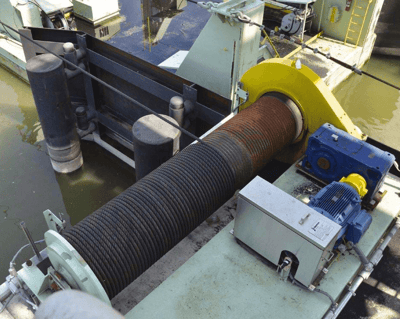Barge Haul
Brand: ValmetWhether your application calls for moving one barge or five barges, Metso can engineer a barge puller to meet your needs.
From basic, opposed units to an arrangement complete with hydrostatic, DC, AC, flux vector or variable frequency drives, breasting winches and a power take-up.
Equipment selection for your project depends on a number of factors, like the size and number of barges you have to move, the river current, the travel required, the available cells, docks or dolphins, and the speed of operation.
Even the mode of operation is important, including how many passes will be required to load or unload.
Seasonal river or pool fluctuations must also be considered. Working against near flood conditions or high currents requires a very large puller. Forces on the front of the barge created by the current increases exponentially with river velocity.
Today’s “jumbo” barge is typically 35 feet wide and 195 feet long. With a draft of 9 feet, the cargo can be 1,500 tons. Empty weights vary, but usually run from 350 tons to 450 tons when covers are added.
Most barges have a flat end and a raked end. Rakes are usually 45°. It takes less force to move the barge against the current when the rake end is upstream.
Two types of sheaves are typically used. The shackle type and the “fairlead” type can be provided.
Fairleads are used to reduce sheave wear and provide positive control of the rope where large direction changes or very high catenary tensions are found.
Rope manufacturers recommend a minimum sheave diameter of 20 times the rope diameter. Sheaves with too small a diameter can damage rope and reduce rope life.
Selection of rope size is quite important. Catenary tension (the tension created by hanging the rope between two supports) is added to the tension generated by pulling barges.
The tension increases with the square of the distance between the supports.
